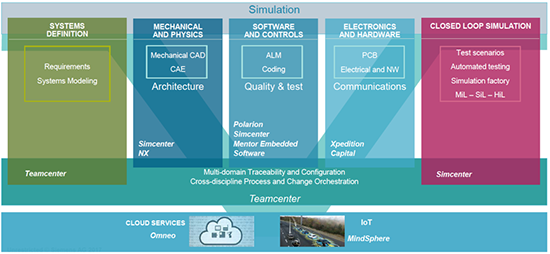The German energy company will install a complete thermal twin for the plant in Lalitpur, Uttar Pradesh, which is owned by Lalitpur Power Generation Company Limited (LPGCL), part of the Bajaj Group.
Siemens will provide remote performance monitoring and diagnostics from the recently launched Siemens MindSphere Application Center in Gurgaon.
The thermal twin utilizes thermodynamic analysis and machine learning to allow power plant operators to diagnose performance gaps for every asset in the cycle in real time and then provides recommendations for improving efficiency.

Siemens says this “co-creation approach will assist the plant team in identifying and rectifying performance gaps in a timely manner”.
Bajaj Power Ventures managing director R S Sharma said the digital solutions “are aimed at improving power plant performance and optimizing operations. The solutions, once executed, will result in sustainable and efficient power generation.”
Laura Anderson, head of Siemens Gas & Power Services’ Controls and Digitalization unit, said the company’s digital products and solutions “are providing customers in India and around the world with the tools to navigate changing market requirements and meet their operational goals. Close collaboration from inside our MindSphere Application Centers enables us to work together with our customers to fully realize the value behind their data.”
The first unit of 1320 MW Payra coal-fired power plant went into test operation today.
“The plant is now generating 100MW power . . . the production will go up to 660MW when it will go into full operation,” said a power division official.
The unit, put into operation utilising the 400 kV Payra-Gopalganj power transmission, was commissioned on December 31 for evacuating power from the
power plant, said the official.

The plant is being developed by Bangladesh China Power Company (BCPCL); a 50:50 joint venture between China National Machinery Import and Export (CMC)
and Bangladesh’s state-owned North-West Power Generation Company (NWPGCL).
The $2bn Payra power project is financed through 30 percent equity investment provided by BCPCL partners and 70 percent debt provided through loan from Chinese banks led by Chinese Export Import (Exim) Bank.
The power plant will consist of two 660MW ultra-supercritical coal-fired power generating units.
The coal requirement for the plant is estimated to be 4.12 million tonnes per year (Mt/y), which will be imported from Indonesia, China and Australia.
Brown coal can be transformed into a number of different products including liquid fuels, substitute natural gas, industrial chemicals, urea fertiliser and hydrogen.
Other opportunities for brown coal
Converting coal to liquid or gaseous fuels
Technology to convert coal to liquid or gaseous fuels has been available in various forms since the 1920s, and a number of commercial plants in other countries are in operation today.
However, in an increasingly energy hungry world, the economics are changing. As a low cost feedstock, coal converted into commodities such as diesel, methanol and its derivatives has the potential to compete with traditional feedstocks and other energy alternatives, such as oil, gas and black coal.
Drying brown coal
The adoption of suitable drying technologies could enable brown coal to be exported and compete directly in black coal markets as an energy and feedstock resource.
Potential coal derivative products
Solid fuel products
In its raw form, brown coal can be used for boiler fuel in power generation. Drying technologies can transform the product into high energy briquettes and pellets that may compete with black coal as an exportable fuel.
Chars and cokes may potentially be derived from brown coal for pyrometallurgical applications, to produce reductants and carbonising chemicals and as a general carbon source for other applications.
Calcium loaded char can be used in water and waste treatment and as an ion-exchange medium.
Brown coal can also be refined into a purer form of carbon for use in production of a number of carbon products including carbon fibres, carbon anodes, activated carbons, filter aids, pigments, graphite lubricants and conductors and formed carbon materials.
Gaseous products
Gasification can be used to convert solid coal into a gaseous feedstock, which can be used to make a range of other products.
Gasification produces synthesis gas or syngas, a mixture of mostly carbon monoxide and hydrogen. The process can also help with separation of carbon dioxide for use of sequestration.
Victoria has had a long history of brown coal gasification. It provided town gas in the Latrobe Valley before natural gas from Bass Strait became available in the 1960s.
Liquid products
Liquid products from coal can be produced either from syngas via gasification or by the direct liquefaction of brown coal.
Gasification can produce liquid fuel products such as diesel, methanol, fuel gasoline blends, and high octane gasoline extenders.
Liquefaction generally produces lower quality products, such as synthetic crude oil. Further processing may be used to produce fuel oil, diesel, motor fuel blends, kerosene and heating oil. Non-fuel products may also be produced including solvents, polymers, surfactants, lubricants and a suite of other carbon-based chemicals.
Waxes, resins and polymers
A range of waxes may be produced using products derived from brown coal, as well as phenolic resins and plastics, composites, low strength structural and building materials.
Agricultural products
Raw brown coal can be used as a soil conditioner by providing a source of humic acids for potting mixtures and market gardens and as an ad-mixture to other fertilisers and soil conditioners.
Syngas manufactured from coal can be used to produce ammonia, the key pre-cursor to nitrogenous fertilisers such as urea. At present these fertilisers are more commonly made from oil and natural gas based feedstocks.